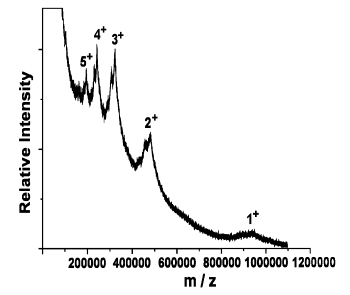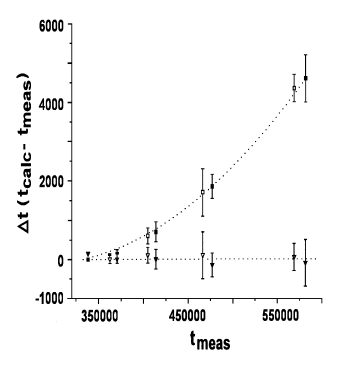
Matrix-assisted laser desorption/ionization time-of-flight mass spectrometry (MALDI-TOF MS) has enabled the analysis of large biomolecules that were previously only amenable to study using conventional techniques (SDS-PAGE, etc.). The technique is routinely used to study molecules in excess of 100,000 Da. We have recently observed singly- charged ions in excess of 1,000,000 Da (1 MDa) from a sample of human immunoglobulin M (IgM). The spectrum is shown below.

A practical consideration in the analysis of such large molecules is the effect of the desorption velocity on the determined mass. The initial desorption velocity and kinetic energy lead to a deviation between calculated and observed flight times. This is demonstrated for a different sample of IgM in the following figure.

The upper curve represents the deviation of the observed flight times from the calculated flight times for the +2 to the +6 charged species of IgM. The lower curve represents the convergence of the observed flight times to the calculated values. A series of successive approximations was used to converge the flight times. Without the correction algorithm, calculated masses may be in error by ~5%, due to an initial energy of ~1500eV.
A compiled QBasic version of the algorithm EnergyCorrect can now be downloaded.
Details of the algorithm may be found in the following publications:
 R. W. Nelson, D. Dogruel, P.
Williams, Rapid. Commun. Mass Spectrom. 8, 627, 1994
R. W. Nelson, D. Dogruel, P.
Williams, Rapid. Commun. Mass Spectrom. 8, 627, 1994  R. W. Nelson, D. Dogruel, P.
Williams, Rapid. Commun. Mass Spectrom. 9, 625, 1995
R. W. Nelson, D. Dogruel, P.
Williams, Rapid. Commun. Mass Spectrom. 9, 625, 1995  D. Dogruel, R. W. Nelson, P. Williams, D. L. Merkle, M. A. Schenerman, S. Johnson,
D. Pfarr, in Proceedings of the 44th ASMS Conference on Mass Spectrometry and Allied Topics, Portland, OR, May 12-16, 1996
D. Dogruel, R. W. Nelson, P. Williams, D. L. Merkle, M. A. Schenerman, S. Johnson,
D. Pfarr, in Proceedings of the 44th ASMS Conference on Mass Spectrometry and Allied Topics, Portland, OR, May 12-16, 1996
Research is continuing on methods to successfully generate time-of-flight mass spectra from extremely large biomolecules and other high-mass materials.
![[ <- ]](images/docsleft.gif) Back to Lab Page
Back to Lab Page  pwilliams@asu.edu Peter Williams
pwilliams@asu.edu Peter Williams